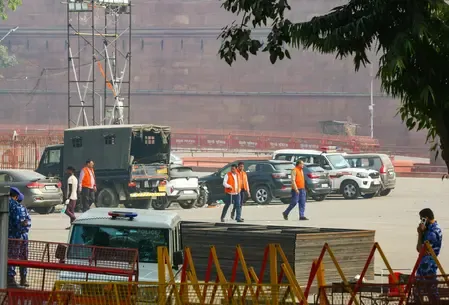Is Faisal Iqbal the Key Figure in the Red Fort Blast Investigation?

Synopsis
Key Takeaways
- Faisal Iqbal is a key figure in the Red Fort blast investigation.
- The operation involved significant planning and coordination by the ISI.
- Over 200 blasts were intended to be executed as part of this scheme.
- The investigation highlights the ISI's network and operational capabilities.
- Local operatives like Mufti Irfan Ahmed Wagay played crucial roles in the execution of the plot.
The investigation into the Delhi Red Fort explosion is honing in on the significant involvement of Pakistan's Inter-Services Intelligence (ISI). An operation of this scale, which included the formation of the Faridabad module, could not have succeeded without institutional support, according to an official. It has been identified that a man named Faisal Iqbal was pivotal in establishing this module. Iqbal, as per an Intelligence Bureau official, is an ISI operative specifically recruited to set up the module and manage an operation that intended to carry out at least 200 blasts.
While his identity as a Pakistani national has been verified, it remains unclear whether he operated from Pakistan or Afghanistan. The ISI planned to execute this entire operation away from Pakistani territory to avoid detection. As part of this investigation, authorities are meticulously examining communications among the module members and their supervisors.
Authorities have discovered that three handlers orchestrated this operation, with the most crucial role being fulfilled by Faisal Iqbal. According to an official, Iqbal provided directives to the suspects on how to create Telegram channels and maintain secrecy regarding their plans and module formation.
It is believed that the module has been in development since 2019, gaining momentum in 2021, and by 2023, it was fully operational. Another official noted that the module's precision and ability to remain undetected strongly indicate that a senior ISI official was involved.
The operation closely mirrors the planning behind the Mumbai 26/11 attacks, characterized by its covert execution. This endeavor included high-ranking officials from the ISI and the Pakistani armed forces, each contributing to the planning, training, logistical support, and execution. Only with such high-level involvement can an operation of this magnitude be successfully carried out.
The establishment of the Faridabad module was completely managed by ISI professionals. The quantity of ammonium nitrate confiscated and the module's intended plans clearly highlight the operation's scale, stated an officer involved in the Red Fort blast investigation. The other two handlers identified in this operation are Ukasha and Hashim.
These handlers were based in the Tora Bora mountains and, along with Iqbal, played crucial roles in radicalizing and guiding the module members, as revealed by the investigation. Although this operation was entirely overseen from abroad, the ISI saw fit to include a local operative. They chose Mufti Irfan Ahmed Wagay from Jammu and Kashmir. His chat transcripts with module members and handlers significantly illustrate his involvement.
Wagay was behind the propaganda posters of Jaish-e-Mohammad that appeared in Nowgam in October, which prompted a probe by the Jammu and Kashmir police that ultimately led to the dismantling of the Faridabad module. Investigators identify Wagay as a cleric from Shopian, who facilitated the transfer of funds and weapons while also engaging in the indoctrination of the module's members.
He maintained close contact with Dr. Shaheen Saeed, who was responsible for recruitment and radicalization. Other conspirators include Muzammil Ahmed Ganai, from whose rented flat in Faridabad roughly 350 kg of ammonium nitrate was recovered, along with Adeel Ahmed Rather and Dr. Umar Nabi, who drove the vehicle that exploded near the Red Fort.








